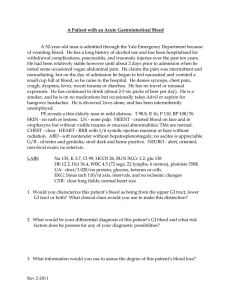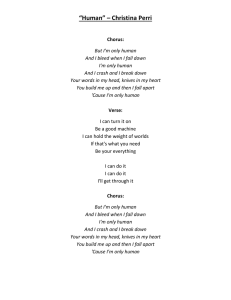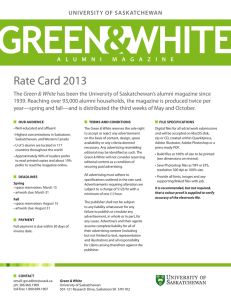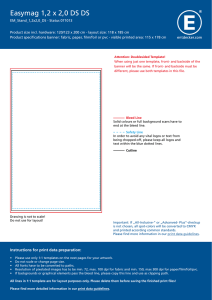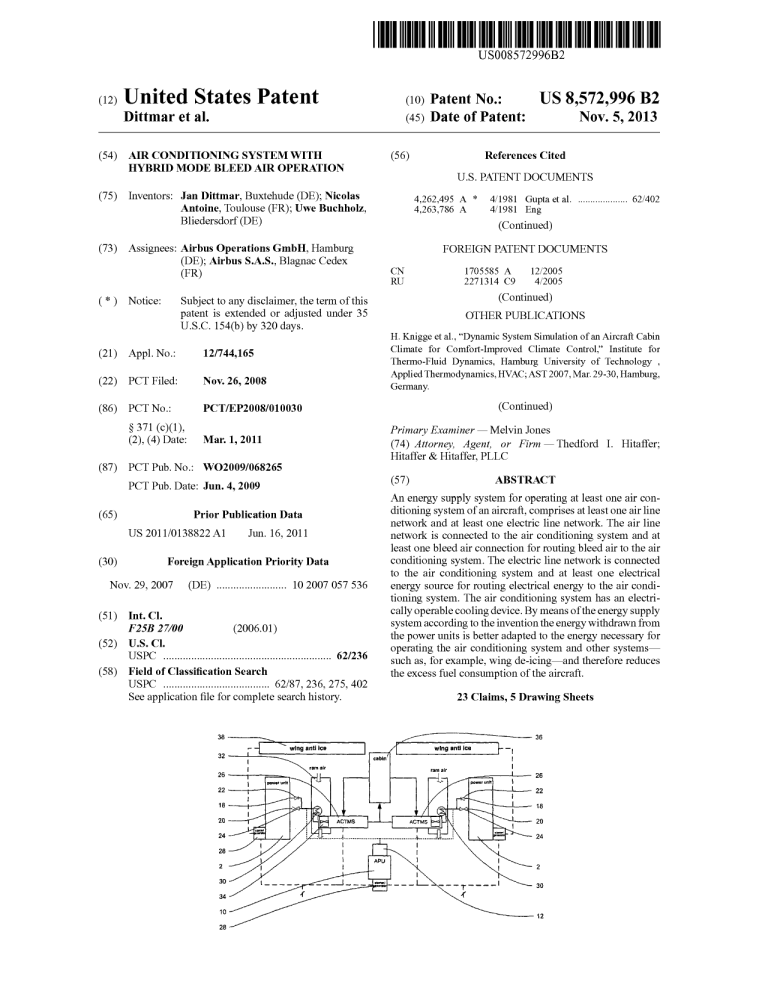
US008572996 B2
(12) United States Patent
(10) Patent No.:
Dittmar et al.
(54) AIR CONDITIONING SYSTEM WITH
(56)
HYBRD MODE BLEED AIR OPERATION
(73) Assignees: Airbus Operations GmbH, Hamburg
(DE); Airbus S.A.S., Blagnac Cedex
(FR)
References Cited
4.262.495 A * 4, 1981 Gupta et al. .................... 62/402
4,263,786 A
4/1981 Eng
(Continued)
FOREIGN PATENT DOCUMENTS
CN
RU
1705585 A
2271314 C9
12/2005
4/2005
Subj
disclai
h term off thi
ubject to anyy d1Sclaimer,
the
this
(Continued)
patent is extended or adjusted under 35
U.S.C. 154(b) by 320 days.
OTHER PUBLICATIONS
(21) Appl. No.:
12/744,165
(22) PCT Filed:
Nov. 26, 2008
(86). PCT No.:
PCT/EP2008/O1OO3O
S371 (c)(1),
(2), (4) Date:
Mar. 1, 2011
Prior Publication Data
US 2011 FO138822 A1
Jun. 16, 2011
Foreign Application Priority Data
Nov. 29, 2007
(DE) ......................... 10 2007 057 536
(51) Int. Cl.
F25B 27/00
(Continued)
Primary Examiner — Melvin Jones
(74) Attorney, Agent, or Firm — Thedford I. Hitaffer;
(57)
PCT Pub. Date: Jun. 4, 2009
(65)
H. Knigge et al., “Dynamic System Simulation of an Aircraft Cabin
Climate for Comfort-Improved Climate Control.” Institute for
Thermo-Fluid Dynamics, Hamburg University of Technology ,
Applied Thermodynamics, HVAC; AST 2007, Mar. 29-30, Hamburg,
Germany.
Hitaffer & Hitaffer, PLLC
(87) PCT Pub. No.: WO2009/068265
(30)
Nov. 5, 2013
U.S. PATENT DOCUMENTS
(75) Inventors: Jan Dittmar, Buxtehude (DE); Nicolas
Antoine, Toulouse (FR); Uwe Buchholz.
Bliedersdorf (DE)
*) Not
Ot1Ce:
US 8,572,996 B2
(45) Date of Patent:
(2006.01)
(52) U.S. Cl.
USPC ............................................................ 62A236
(58) Field of Classification Search
USPC ...................................... 62/87, 236, 275, 402
See application file for complete search history.
wing antice
ABSTRACT
An energy Supply System for operating at least one air con
ditioning system of an aircraft, comprises at least one airline
network and at least one electric line network. The air line
network is connected to the air conditioning system and at
least one bleed air connection for routing bleed air to the air
conditioning system. The electric line network is connected
to the air conditioning system and at least one electrical
energy source for routing electrical energy to the air condi
tioning system. The air conditioning system has an electri
cally operable cooling device. By means of the energy Supply
system according to the invention the energy withdrawn from
the power units is better adapted to the energy necessary for
operating the air conditioning system and other systems—
Such as, for example, wing de-icing—and therefore reduces
the excess fuel consumption of the aircraft.
23 Claims, 5 Drawing Sheets
US 8,572.996 B2
Page 2
(56)
References Cited
U.S. PATENT DOCUMENTS
6.427.471 B1
8, 2002 Ando
2002/0113167 A1
8, 2002 Albero
2004/01298.35 A1
7/2004 Atkey
FOREIGN PATENT DOCUMENTS
WO
WO
2002066324 A2
2004037641 A2
8, 2002
5, 2004
DeQi's English Summary of the First Office Action Text.
WO 2009/068265 A1, International Search Report.
WO 2009/068265 A1, Transmittal of International Search Report,
Written Opinion of International Searching Authority, International
Search Report, Written Opinion of International Searching Authority
(PCT Rule 43bis. 1).
AP, ARS-Patent, Intellectual Property Law Firm, Saint Petersburg,
Russia, Letter from Russian Association Summarizing First Russian
Office Action dated Oct. 23, 2012.
First Russian Office Action, dated Oct. 23, 2012.
OTHER PUBLICATIONS
CN 100083, First Office Action, dated Jul. 4, 2012.
* cited by examiner
U.S. Patent
Nov. 5, 2013
Sheet 1 of 5
US 8,572,996 B2
U.S. Patent
Nov. 5, 2013
Sheet 2 of 5
US 8,572,996 B2
U.S. Patent
Nov. 5, 2013
Sheet 3 of 5
US 8,572,996 B2
U.S. Patent
Nov. 5, 2013
Sheet 4 of 5
US 8,572,996 B2
prior art
time
system according to the invention
time
Fig. 4
U.S. Patent
Nov. 5, 2013
Sheet 5 of 5
Withdrawal of bleed air from
US 8,572,996 B2
each two) bleed air connections at
power units or separate compressor
Alternative:
54
56
Air via additional fan and external
air inlet to air conditioning system
when on the ground
Regulate volumetric flow rate
and pressure via throttle valve
58
60
Regulate volumetric flow rate
and pressure via throttle valve
o
Route to air conditioning device
via air line network
Precooling via heat exchanger
disposed in ram air channel
Operation of an additional fan
in the ram air channel
-- 62
64
---
when on the ground
Operation of an electrical cooling
unit supplied
via an electric
line network
68
66
Fig. 5
US 8,572,996 B2
1.
AIR CONDITIONING SYSTEM WITH
HYBRD MODE BLEED AIR OPERATION
CROSS REFERENCE TO RELATED
APPLICATIONS
This application is the National Phase of International
Application PCT/EP2008/010030, filed Nov. 26, 2008,
which designated the U.S. and that International Application
was published in English under PCT Article 21(2) on Jun. 4,
10
2009 as International Publication Number WO/2009/068265
A1, the disclosure of which is incorporated herein by refer
ence. PCT/EP2008/010030 claims priority to German Patent
Document No. 10 2007 O57536.1.
The invention relates to an energy Supply system for oper
ating at least one air conditioning system of an aircraft, an air
conditioning system for an aircraft and a method for air
conditioning an aircraft.
In order to Supply aircraft air conditioning systems and
other systems such as, for example, de-icing systems with
energy and fresh air, air is usually withdrawn from a com
pressor stage of a power unit or of a compressor driven by an
APU and routed to air conditioning system units ("packs') as
well as wing anti-icing systems. During flight this heated and
pressurised air, which is also called "bleed air, represents the
sole energy source for the air conditioning system units, the
energy of which must be sufficient both to pressurise the
aircraft cabin and to operate the corresponding refrigeration
process. The pressure requirement of the various systems to
be supplied with bleed air determines the necessary pressure
at the bleed air connection of the compressor stage of the
power unit or of the compressor driven by the APU. The
decisive factor here is in particular the requirement of the
packs, which need a relatively high air pressure for operating
the thermodynamic cycle and for feeding cold or fresh air into
15
the throttle and withdrawal valves at the bleed air connec
25
30
network, wherein the airline network is connected to the air
40
45
50
aircraft.
In addition to the energy Supply of the actual aircraft air
conditioning system, bleed air is also routed into a line net
work inside the wing leading edge flaps (“slats”) in order to
heat the inside of the slats here, so that the formation of an ice
layer on the outside of the slats is prevented.
In the case of a conventional pneumatic and bleed air-based
air conditioning and energy Supply system, bleed air from a
compressor which is driven by the APU is also used to start
one or a plurality of the main power units of the aircraft by
means of a pneumatic power unit starter unit. This pneumatic
based energy architecture is a Sturdy and proven system
which is used in many aircraft throughout the world. However
this method of bleed air-based extraction of energy from
power units represents a distinct disadvantage of the gas
turbine process taking place here. Since, moreover, the bleed
air connections are disposed in a mechanically fixed manner
The object is achieved by an energy Supply system for
Supplying at least one air conditioning system of an aircraft,
with at least one airline network and at least one electric line
direction into the environment of the aircraft with an addi
tional heat input from the bleed air which is to be cooled and
is no longer available as an energy carrier for further use in the
tions, which reduces their service life accordingly.
The object of the invention is to reduce or eliminate the
above-mentioned disadvantages. The object of the invention
is in particular to propose an energy Supply system of the type
initially mentioned with which the withdrawal of bleed air
from the power units of the aircraft is optimised such that the
power which is withdrawn from the power units corresponds
substantially to the power which is necessary for the air
conditioning system. The object of the invention is also to
minimise excess fuel consumption, which would result from
throttle and heat losses of power unit power withdrawn in
CXCSS.
35
the cabin.
However a higher necessary bleed air pressure also results
in a higher bleed air temperature on account of the more
intense compression in the power unit. In order to prevent
damage in components receiving bleed air, the bleed air must
be limited to a predetermined maximum temperature and
consequently also cooled by a precooler dependent upon its
temperature. The operation of a precooler which is designed
as a heat exchanger necessitates an additional medium which
absorbs heat and is usually in the form of bleed air of a low
pressure level from a fan stage of a main power unit of the
aircraft. This cooling air leaves the precooler in the outward
2
inside the power units, the bleed air pressure at the bleed air
connections varies with different power unit states. This
makes it more difficult to bring the quantity of pneumatic
energy which is withdrawn into line with the energy neces
sary for operating the systems. The positions of the bleed air
connections are generally designed so that the bleed air pres
Sure available here is always Sufficient in all design situations
to correctly operate the aircraft air conditioning system (for
example in the case of a hot environment or various fault
situations). This means that the bleed air pressure applied to
the bleed air connections distinctly exceeds the required
bleed air pressure under normal conditions. This discrepancy
requires the use of pressure and Volumetric flow rate regulat
ing valves, whereby some of the energy withdrawn from the
power units is negated or remains unused. This results, at
most operating points, in an excess withdrawal of bleed air
power from the power unit and thereby a distinct excess fuel
consumption overall.
A further disadvantage of a conventional air conditioning
system based entirely on bleed air lies in the accelerated
material fatigue, caused by the high bleed air temperature, of
55
60
65
conditioning system and at least one bleed air connection for
routing bleed air to the air conditioning system, the electric
line network is connected to the air conditioning system and
at least one electrical energy source for routing electrical
energy to the air conditioning system, and the air conditioning
system has an electrically operable cooling device.
An energy Supply system of this kind enables bleed air to
be withdrawn from power units at a relatively low pressure
level. In this respect the withdrawn bleed air does not serve to
completely operate an air conditioning process which
includes pressurisation of the cabin and cooling. The energy
Supply system according to the invention rather provides
bleed air which at least guarantees pressurisation of the cabin
in all operating states. The energy necessary in addition for
cooling the fresh air routed to the cabin is provided by an
electrical cooling system. This hybrid pneumatic and electri
cal Supply of the air conditioning system is an advantageous
possibility of adapting the energy withdrawn from the power
units to the necessary energy as accurately and with as little
losses as possible. The deviations in the ambient temperature
which are to be expected during usual aircraft uses do not
have to be taken into account when planning the bleed air
withdrawal, but can instead easily be compensated by the
electrical cooling.
In one advantageous development bleed air is withdrawn
from two bleed air connections in each case at the power
units, the respective bleed air connections of a power unit
being at different pressures. This results in further optimisa
tion of the withdrawal of the bleed air and a reduction of the
US 8,572,996 B2
4
FIG. 1 represents an air conditioning and energy Supply
system from the prior art. Here bleed air is withdrawn from
connection.
power units 2 and cooled down to a temperature which is
By withdrawing bleed air at a relatively low pressure level, acceptable for downstream appliances by means of precool
the temperature of the bleed air is lower than in the case of 5 ers 4. The medium absorbing heat in the precoolers 4 is
conventional systems. As a result, no conventional bleed air cooling air in the form of bleed air which is withdrawn from
operated precooler is necessary in the system according to the a fan stage of the power units 2 and is at a relatively low
invention. The use of a precooling system consisting of a ram temperature. This cooling air absorbs heat of the hotter bleed
air channel and a heat exchanger disposed therein requires no air from the bleed air connections which are nearer to the
further energy Supply and therefore represents a distinct sav 10 combustion chambers of the power units and leaves the pre
ing interms of excessfuel consumption. In addition to this, no coolers 4 into the environment of the aircraft. The energy
bleed air leakage detection device is necessary in the ideal absorbed by the cooling air and coming from the power units
case. This is due to the fact that, given a configuration which 2 therefore leaves the area of the air conditioning system
is optimised in terms of pressure losses, the bleed air can be without returning.
tapped at a pressure level at which the associated bleed air 15 In this way precooled bleed air passes into the air condi
temperature is so low that no safety-critical Surface tempera tioning units ("packs') 6, in which it is accordingly condi
tures arise in the event of a leakage in the bleed air system. It tioned by thermodynamic processes—in the case of larger
is therefore no longer necessary to detect the leakage for commercial aircraft, for example, by means of an expansion
safety reasons. It is thus possible to dispense with the com cooling system—and routed to a mixing chamber. The con
plex installation of a detection system, resulting in a reduction ditioned air is mixed in the mixing chamber with used air
in weight, costs and manufacturing times when assembling from the cabin in a certain mixing ratio and Supplied to the
the aircraft.
cabin. The bleed air is in this respect the sole energy source for
The lowering of the bleed air temperature also leads to a operating the packs 6 and for pressurising the cabin.
The bleed air flowing out of the precoolers 4 also passes
longer service life and longer intervals between maintenance
of the bleed air valves, as the thermal load thereof lies at a 25 into the wing anti-icing systems 8, in which it strikes the wing
leading edge and prevents the formation of ice here through
level which is tolerable when compared with the prior art.
The replacement of conventional pneumatic power unit the input of heat.
starter units by generator/starter units which are integrated
It is also usual in the prior art to operate the air conditioning
into the power units simplifies the air line network in the system of the aircraft when on the ground with air from a
aircraft which routes bleed air. The simplification of the air 30 compressor 12 driven by an APU 10 (also called “load com
line network is increased by replacing a pneumatic de-icing or pressor in the following in the sense of the English term).
wing anti-icing system by electrical systems. Consequently The air provided by the load compressor 12 is in addition used
no further withdrawal of bleed air is necessary during flight in to start the power units 2 by means of a pneumatic power unit
icing-up conditions, so that the bleed air connections can be starter unit 14.
designed for a lower Volumetric flow rate and pressure, and 35 Electrical energy is provided by the generators 16 of the
the withdrawal of energy from the power units is thereby power units 2 or of the APU 10, although this is not used by
additionally optimised.
the most important Sub-systems of the air conditioning sys
If a fully electric APU for example in the form of a fuel tem of the aircraft.
The first embodiment represented in FIG. 2 of the system
cell or similar is used in the aircraft in question, the air
Supply when on the ground can be provided either by an 40 according to the invention follows a different approach to the
electrically driven fan and/or an external air inlet. The main use of pneumatic and electrical energy and results in a lower
tenance costs and the construction space of the APU are at the fuel consumption.
same time reduced.
Bleed air is extracted from the power units 2 at a pressure
The object is also achieved by an air conditioning system level which—compared with conventional systems—is rela
and a method for air-conditioning an aircraft having the fea 45 tively low. Dependent upon the actual flight condition of the
3
throttle losses which would occur upon reducing the pressure
and the Volumetric flow rate when using a single bleed air
tures of the co-ordinated claims.
aircraft, the bleed air can be extracted from two different
The invention is illustrated in detail in the following on the
basis of the figures. The same objects are marked by the same
reference characters in the figures, in which:
FIG. 1 is a schematic view of an air conditioning and
energy system from the prior art,
bleed air connections 18 and 20, which provide different
bleed air pressures. On account of the low pressure level, the
resultant bleed air temperature is in a range in which a pre
cooler 4 is no longer required. The bleed airline network has
a non-return valve 22 at the connecting point with the bleed
air connection 18 of a low pressure in order to prevent a return
flow of the bleed air into the power unit 2, while the bleed air
is extracted from the bleed air connection 20 of a higher
pressure. The bleed airline network also has a throttle valve
24 in the flow path of the bleed air connection 20 of a higher
pressure in order to regulate the pressure and Volumetric flow
rate of the bleed air, so that at least the necessary cabin
pressure can be maintained through the action of the bleed air.
If the power units 2 are not in operation on the ground, air
is provided by means of a load compressor 12 driven by the
APU 10. In contrast to common systems, the required pres
sure of the air which is to be provided by the APU is relatively
low, as the air conditioning system 26 (alternatively to this
general term also called “Air Conditioning and Thermal Man
agement System” or ACTMS) is also operated by electrical
energy to a certain degree. The cold production inside the
50
FIG. 2 is a schematic view of a first embodiment of the
system according to the invention,
FIG. 3 is a schematic view of a second embodiment of the
system according to the invention,
FIGS. 4a, b show a comparison of the bleed air pressure
variation of a system from the prior art and of the system
according to the invention, and
FIG. 5 is a schematic representation of the method accord
ing to the invention.
The systems which are represented in FIGS. 1-3 are of a
symmetrical structure and consist, by way of example, of two
mirror-inverted System halves. The use of singular and plural
in relation to system components is to be interpreted together
with a consideration of the figures, as it appears most appro
priate to describe an individual system half with individual
system components.
55
60
65
US 8,572,996 B2
5
ACTMS can in this respect be based both on an air-assisted
and on a vapour-assisted refrigeration process. The electrical
energy is provided by an electrical generator/starter unit 28
which is driven by the APU 10. The APU 10 could be in the
form either of a conventional gas turbine or, in future, also of
a fuel cell. Should a fuel cell be selected for this purpose, the
load compressor 12 is driven by an electric motor, which is
not represented and derives its electrical energy from the fuel
5
cell.
During flight extracted air is routed away from the bleed air
connections 18 and 20 to a heat exchanger 30, in which it is
cooled by means of through-flowing ram air. For this purpose
the ram air is provided via integrated ram air channels 32
through ram pressure during flight—or through ram air fans
34 integrated into the air conditioning system 26 when on the
ground.
The air conditioning system 26 serves to completely pro
vide the temperature regulation for the cabin 36 and the
cockpit, which is not represented, as well as additional cool
ing for the flight computer and power electronics. The cooling
through the air conditioning system 26 can be implemented
either with common thermodynamic air cycles, evaporator
cooling circuits or other thermodynamic cycles which appear
Suitable for obtaining the necessary cabin air temperature. In
addition to the bleed air, the air conditioning system 26 is
Supplied with electrical energy from the generator/starter
units 28, which are driven by the power units 2 or the APU 10.
The additional electrical energy is determined by a regulating
unit, which is not represented, in order to better adapt the
energy extracted from the power units 2 to the energy require
ment of the air conditioning system 26.
The generator/starter units 28 are—as can be assumed
from the name—designed so that they can be used not just as
generators, but also as starter units for starting the power units
2 or the APU 10. In order to start the power units 2 (or a first
power unit 2), electrical energy is provided from the genera
tor/starter unit 28 of the APU 10 or alternatively by external
power generators ('ground power units').
Also used in the system according to the invention are wing
anti-icing systems 38 which are based on electrical energy
and are supplied by the generator/starter units 28 of the power
units 2 and the APU 10. In this respect the anti-icing systems
38 can be in the form both of thermal systems using electrical
heating mats or similar for heating the outer Surface of wing
leading edge flaps and of electromechanical systems which
can mechanically free wing leading edge flaps from ice.
A second embodiment of the system according to the
10
15
25
30
35
40
45
invention is shown in FIG. 3. The fundamental difference of
the second embodiment in relation to the first lies in the
6
compared by way of example. In FIG. 4a a dot-dash curve 44
indicates the bleed air pressure which is necessary to operate
an air conditioning system on a day with an average tempera
ture. A dashed line 46 represents the necessary bleed air
pressure requirement for a relatively hot day. As the bleed air
pressure which is provided has to satisfy all conceivable
design situations, the bleed air pressure which is applied to
the bleed air connections always lies above the necessary
bleed air pressures, so that the curve 48 representing the
applied bleed air pressure lies above the curves 46 and 44.
In the system according to the invention the applied bleed
air pressure represented by the curve 50 is only higher than
the necessary bleed air pressure at an average temperature
(curve 52) or in relatively hot weather (curve 54) in certain
areas. The pressure and the volumetric flow rate of the with
drawn bleed air only have to be throttled during flight sections
in which a relatively high thrust is required. During cruising,
however, the bleed air pressure is only sufficient for pressuris
ing the aircraft cabin, but not for cooling. The resulting energy
difference, which is represented by the area between the
curves 50 and 52 or 54, is exactly compensated by electrical
energy from the generator/starter units 28 which is made
available to the air conditioning system 26 for the purpose of
cooling the bleed air.
Finally, FIG. 5 represents in schematic form the method
according to the invention for operating an aircraft air condi
tioning system. The method according to the invention begins
with the provision of air in the form of bleed air which is
withdrawn 54 from the power units of the aircraft, for instance
via two bleed air connections 18 and 20 or from a separate
load compressor 12 driven, for example, by an APU 10. As an
alternative to this, air is provided 56 via an additional air inlet
42 and an additional fan when the aircraft is on the ground.
The pressure and the volumetric flow rate of the bleed air from
the bleed air connections 18 and 20 are in this respect regu
lated 58 by means of throttle valves 24. In order that a return
flow of bleed air, for example from a bleed air connection of
a higher pressure via a bleed air connection of a lower pres
sure, does not take place, the return flow is prevented 60 by
means of a non-return valve 22. The air which is provided is
then routed 62 to the air conditioning system and precooled
64 via aheat exchanger 30 disposed in the ram air channel32.
When the aircraft is on the ground an additional fan 34 in the
ram air channel 32 is operated 66 in order to enable precool
ing to take place via the heat exchanger 30. The air which is
routed to the air conditioning system is finally cooled 68 via
an electrical cooling unit which is Supplied with electrical
energy by the electric line network.
different operating mode when on the ground. In the second
embodiment the cabin air is not provided by a load compres
sor 12 driven by the APU 10, but by an additional fan which
is not represented in detail and is integrated into the air con
ditioning system 26. During ground handling a valve 40 is
opened and outside air is withdrawn from an outside air inlet
42 which is integrated into the ram air channel32. As soon as
the power units 2 are put into operation and are capable of
supplying bleed air, the valve 40 is closed and the air condi
tioning and energy Supply system is operated in the same way
50
55
the air line network is connected to the air conditioning
system and to at least one bleed air connection for rout
ing bleed air to the air conditioning system,
the air conditioning system includes an electrically oper
able cooling device,
as described in the case of the first embodiment on the basis of
FIG. 2. The second embodiment enables the bleed air line
60
the electric line network is connected to the air condition
1. Energy Supply system for operating at least one air
conditioning system of an aircraft, comprising
at least one air line network and at least one electric line
network, wherein
network to be minimised and makes a fully electric APU
possible. This results in advantages in terms of weight, space
and maintenance costs.
Finally, the bleed air pressure variations of a common air
conditioning and energy system (FIG. 4a) and of the system
according to the invention (FIG. 4b) over the flight time are
The invention claimed is:
65
ing system and at least one electrical energy source,
which is a generator/starter unit, for routing electrical
energy to the air conditioning system, and wherein
the generator/starter unit is adapted to compensate an
energy difference between energy required for cooling
and energy provided by the bleed airby electrical energy
provided by the generator/starter unit.
US 8,572,996 B2
7
2. Energy Supply system according to claim 1,
in which no precooler operated by bleed air is provided.
3. Energy Supply system according to claim 1,
with at least one ram air channel through which ram air
flows during flight and which has a heat exchanger
5
which can be connected to the airline network.
4. Energy Supply system according to claim 3,
wherein an additional fan to make airflow through the ram
air channel when on the ground is integrated into the ram
air channel.
10
5. Energy Supply system according to claim 1,
in which the engines of the aircraft each have two bleed air
connections at different pressure levels which are con
nected to the airline network.
6. Energy Supply system according to claim 5.
in which the respective bleed air connection of a higher
pressure has a throttle valve for regulating the pressure
15
and/or Volumetric flow rate of the bleed air withdrawn
from the bleed air connection.
7. Energy Supply system according to claim 5.
in which the respective bleed air connection of a lower
pressure has a non-return valve for preventing the return
flow of bleed air from the bleed air connection of a
higher pressure via the bleed air connection of a lower
pressure into the engine.
8. Energy Supply system according to claim 1,
in which the bleed air is withdrawn from a compressor
driven by an APU.
9. Energy Supply system according to claim 1, with an
external air inlet and an additional fan for Supplying the air
conditioning system with air when on the ground.
10. Energy supply system according to claim 9.
wherein the external air inlet is integrated into the ram air
nected to the airline network.
25
30
channel.
11. Energy Supply system according to claim 8.
in which the engines and the APU of the aircraft are each
equipped with a generator/starter unit as an electrical
energy source, wherein the generator/starter units are
further adapted to start the engines electrically without
bleed air.
35
45
pressure from a respective bleed air connection of a
higher pressure is regulated by means of a throttle valve.
21. Method according to claim 15,
tion of a higher pressure via a bleed air connection of a
lower pressure into the engine is prevented by means of
22. Method according to claim 15,
in which the bleed air is withdrawn from a compressor
driven by an APU.
23. Method according to claim 15,
in which air is routed via an additional fan and an external
the use of bleed air.
wherein
in which the bleed air volumetric flow rate and bleed air
a non-return valve.
circuit.
14. Air conditioning system for an aircraft which is con
nected to the energy Supply system according to claim 1,
18. Method according to claim 15,
in which an additional fan is operated to make air flow
through the ram air channel when the aircraft is on the
ground.
19. Method according to claim 15,
in which the bleed air is withdrawn from two respective
bleed air connections at different pressure levels of the
engines of the aircraft.
20. Method according to claim 15,
in which a return flow of bleed air from a bleed air connec
40
12. Energy Supply system according to claim 1,
in which the cooling device is further adapted to be oper
ated by bleed air by means of an expansion cooling
13. Energy Supply system according to claim 1, and further
adapted to Supply a de-icing system with electrical energy,
wherein the de-icing system is adapted for operation without
8
the air line network routes bleed air for pressurising the
cabin of the aircraft to the air conditioning system, and
the electric line network routes electrical energy for
operating the electrical cooling device to the air condi
tioning system.
15. Method for air-conditioning an aircraft using an energy
Supply system according to claim 1, in which in which the
generator/starter unit is controlled to compensate an energy
difference between energy required for cooling and energy
provided by the bleed airby electrical energy provided by the
generator/starter unit,
wherein the bleed air is cooled by an electrically operable
cooling device powered via at least one electric line
network, and wherein the energy required for cooling of
the bleed air is provided by the generator/starter unit in
the form of electrical energy.
16. Method according to claim 15,
in which the bleed air is not precooled by a precooler
operated by bleed air.
17. Method according to claim 15,
in which the bleed air is precooled by a heat exchanger
which is disposed in a ram air channel and can be con
50
air inlet into the air conditioning system when the air
craft is on the ground.
k
k
k
k
k

